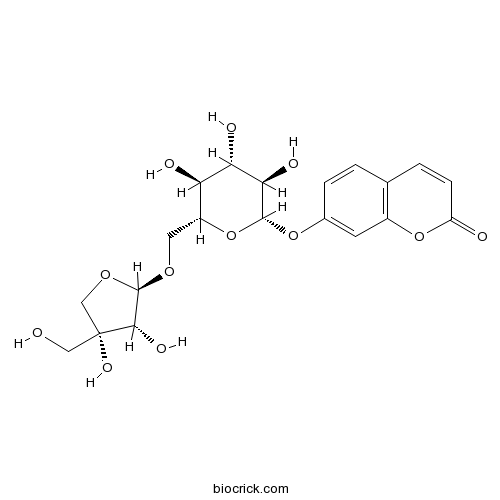ApiosylskimminCAS# 103529-94-8 |

Quality Control & MSDS
3D structure
Package In Stock
Number of papers citing our products

| Cas No. | 103529-94-8 | SDF | Download SDF |
| PubChem ID | 14236613 | Appearance | Powder |
| Formula | C20H24O12 | M.Wt | 456.40 |
| Type of Compound | Coumarins | Storage | Desiccate at -20°C |
| Solubility | Soluble in Chloroform,Dichloromethane,Ethyl Acetate,DMSO,Acetone,etc. | ||
| Chemical Name | 7-[(2S,3R,4S,5S,6R)-6-[[(2R,3R,4R)-3,4-dihydroxy-4-(hydroxymethyl)oxolan-2-yl]oxymethyl]-3,4,5-trihydroxyoxan-2-yl]oxychromen-2-one | ||
| SMILES | C1C(C(C(O1)OCC2C(C(C(C(O2)OC3=CC4=C(C=C3)C=CC(=O)O4)O)O)O)O)(CO)O | ||
| Standard InChIKey | SXPBJYHKMRWZNA-ZITSYKRSSA-N | ||
| General tips | For obtaining a higher solubility , please warm the tube at 37 ℃ and shake it in the ultrasonic bath for a while.Stock solution can be stored below -20℃ for several months. We recommend that you prepare and use the solution on the same day. However, if the test schedule requires, the stock solutions can be prepared in advance, and the stock solution must be sealed and stored below -20℃. In general, the stock solution can be kept for several months. Before use, we recommend that you leave the vial at room temperature for at least an hour before opening it. |
||
| About Packaging | 1. The packaging of the product may be reversed during transportation, cause the high purity compounds to adhere to the neck or cap of the vial.Take the vail out of its packaging and shake gently until the compounds fall to the bottom of the vial. 2. For liquid products, please centrifuge at 500xg to gather the liquid to the bottom of the vial. 3. Try to avoid loss or contamination during the experiment. |
||
| Shipping Condition | Packaging according to customer requirements(5mg, 10mg, 20mg and more). Ship via FedEx, DHL, UPS, EMS or other couriers with RT, or blue ice upon request. | ||
| Description | Apiosylskimmin is a natural product from Angelica gigas. |
| In vitro | Antiplasmodial and cytotoxic activity of coumarin derivatives from dried roots of Angelica gigas Nakai in vitro.[Pubmed: 21428713]Immunopharmacol Immunotoxicol. 2011 Dec;33(4):663-6.The butanol-soluble fraction of the dried root of Angelica gigas exhibited significant protection against chloroquine-sensitive strains of Plasmodium falciparum using the parasite lactate dehydrogenase assay method.
|

Apiosylskimmin Dilution Calculator

Apiosylskimmin Molarity Calculator
| 1 mg | 5 mg | 10 mg | 20 mg | 25 mg | |
| 1 mM | 2.1911 mL | 10.9553 mL | 21.9106 mL | 43.8212 mL | 54.7765 mL |
| 5 mM | 0.4382 mL | 2.1911 mL | 4.3821 mL | 8.7642 mL | 10.9553 mL |
| 10 mM | 0.2191 mL | 1.0955 mL | 2.1911 mL | 4.3821 mL | 5.4777 mL |
| 50 mM | 0.0438 mL | 0.2191 mL | 0.4382 mL | 0.8764 mL | 1.0955 mL |
| 100 mM | 0.0219 mL | 0.1096 mL | 0.2191 mL | 0.4382 mL | 0.5478 mL |
| * Note: If you are in the process of experiment, it's necessary to make the dilution ratios of the samples. The dilution data above is only for reference. Normally, it's can get a better solubility within lower of Concentrations. | |||||

Calcutta University

University of Minnesota

University of Maryland School of Medicine

University of Illinois at Chicago

The Ohio State University

University of Zurich

Harvard University

Colorado State University

Auburn University

Yale University

Worcester Polytechnic Institute

Washington State University

Stanford University

University of Leipzig

Universidade da Beira Interior

The Institute of Cancer Research

Heidelberg University

University of Amsterdam

University of Auckland

TsingHua University

The University of Michigan

Miami University

DRURY University

Jilin University

Fudan University

Wuhan University

Sun Yat-sen University

Universite de Paris

Deemed University

Auckland University

The University of Tokyo

Korea University
- AZD4547
Catalog No.:BCC3711
CAS No.:1035270-39-3
- AZ505 ditrifluoroacetate
Catalog No.:BCC4265
CAS No.:1035227-44-1
- AZ505
Catalog No.:BCC4264
CAS No.:1035227-43-0
- Phyllanthin
Catalog No.:BCN5848
CAS No.:10351-88-9
- 9-Dehydroandrostenedione
Catalog No.:BCC8801
CAS No.:1035-69-4
- Fmoc-D-N-Me-Leu-OH
Catalog No.:BCC3346
CAS No.:103478-63-3
- Fmoc-N-Me-Leu-OH
Catalog No.:BCC3345
CAS No.:103478-62-2
- Fmoc-D-N- Me-Val-OH
Catalog No.:BCC3359
CAS No.:103478-58-6
- Diacetylpiptocarphol
Catalog No.:BCN4737
CAS No.:103476-99-9
- Leupeptin, Microbial
Catalog No.:BCC1217
CAS No.:103476-89-7
- Maprotiline HCl
Catalog No.:BCC4329
CAS No.:10347-81-6
- NMS-1286937
Catalog No.:BCC5358
CAS No.:1034616-18-6
- Huperzine B
Catalog No.:BCN1059
CAS No.:103548-82-9
- 3,7-O-Diacetylpinobanksin
Catalog No.:BCN5849
CAS No.:103553-98-6
- TAK-733
Catalog No.:BCC4587
CAS No.:1035555-63-5
- Lansoprazole
Catalog No.:BCC1058
CAS No.:103577-45-3
- P005672 hydrochloride
Catalog No.:BCC6406
CAS No.:1035979-44-2
- Isookanin
Catalog No.:BCN6476
CAS No.:1036-49-3
- 5,7-Dimethoxyflavanone
Catalog No.:BCN3569
CAS No.:1036-72-2
- RETRA hydrochloride
Catalog No.:BCC2415
CAS No.:1036069-26-7
- Janolusimide
Catalog No.:BCN1840
CAS No.:103612-45-9
- H-Phe(2-Cl)-OH
Catalog No.:BCC3165
CAS No.:103616-89-3
- (±)-5'-Chloro-5'-deoxy-ENBA
Catalog No.:BCC7716
CAS No.:103626-26-2
- Sumatriptan
Catalog No.:BCC5645
CAS No.:103628-46-2
Antiplasmodial and cytotoxic activity of coumarin derivatives from dried roots of Angelica gigas Nakai in vitro.[Pubmed:21428713]
Immunopharmacol Immunotoxicol. 2011 Dec;33(4):663-6.
The butanol-soluble fraction of the dried root of Angelica gigas exhibited significant protection against chloroquine-sensitive strains of Plasmodium falciparum using the parasite lactate dehydrogenase assay method. Using antiplasmodial activity-guided fractionation, five coumarins, marmesinin (1), nodakenin (2), skimmin (3), Apiosylskimmin (4), and magnolioside (5), were isolated and evaluated for in vitro antiplasmodial activity, as well as for their cytotoxic potential on SK-OV-3 cancer cell lines. Compounds 1 and 5 showed notable growth inhibitory activity against chloroquine-sensitive strains of P. falciparum with IC(50) values of 5.3 and 8.2 muM. The compounds showed no significant cytotoxicity (IC(50) > 100 muM) toward the SK-OV-3 cancer cell line. This is the first report on the antiplasmodial activity of these coumarin derivatives from the dried root of A. gigas.


